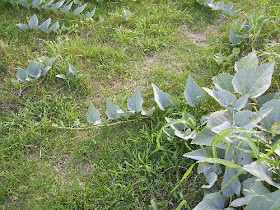Buffalo Gourd, Cucurbita foetidissima H.B.K., is a sun-loving and drought-resistant perennial that is a member of the squash family that thrives in poor soils. It grows wild in many parts of the country and is most often found in open pastures or along fence lines. It is frequently found in most areas of Central Texas.
The roots, stems, and leaves of the buffalo gourd were used for a variety of medicinal purposes by Native Americans and the seeds were considered an important food source in arid or dry regions of the country. The buffalo gourd is also known by several different names. It is also known as wild gourd, Missouri
Buffalo gourd is normally found in pastures, growing along fence lines or alongside roadways.The vines or runners can be several yards in length.
Recognizing this plant is a fairly easy process. The leaves are 9 to 10 inches long and 6 to 8 inches wide and have a very rough texture. The leaves are roughly triangular in shape.
The flowers consist of five petals and are a bright yellow color. The flowers are normally about 4 inches in length. Both male and female flowers are found on the same plant. This condition is known as monoecious.
Unripened Fruit
Size Illustration
It produces small round gourds that are green with vertical off white stripes that are approximately 4 inches long. When the fruit is ripe, it turns a yellowish or light tan color. The seeds are the only part of the ripened fruit and plant that are edible. This is due to the high level of saponins that are found in buffalo gourds. There are significantly lower levels of saponins in domesticated squash and cucumbers.
The seeds were usually roasted and ground into a meal that was mixed with water to make a sort of mush. The seeds were sometimes boiled and then eaten. The seeds contain about a 25 % fat content and are also quite high in their protein content.
The roots of the buffalo gourd are also rich in saponins. The root and the outer shell of the fruit contain high enough concentrations of saponins that they were quite often used as soap.
The root was known to have astringent and disinfectant properties and was quite often used to treat sores or boils.
Due to their tough outer skins, the gourds were often made into spoons or ladles or used for ceremonial purposes in the making of rattles or decorative containers.
Got gourds?
Staying above the water line!










While riding 4wheelers yesterday in the trails at the red river in north Texas we came across these. I took one so I could research it and consider planting them. Thank you for explaining them so well! Just wondering though what other medicinal purposes were they used for? And on the name stinky gourd......SO TRUE!! I now can't wait to go back and get a ripe one and see what it looks like!! How well do they grow in the winter? Or shoud I wait and plant after winter is over? We have been riding the same trail for 2 years and have never ever seen those and there had to have been several hundred to almost 1,000 laying there. Are they edible for animals? There was about 5 dead animals throughout our riding and usually there is none to maybe 1. If they are not edible.and can harm them then we need to rush back and get them all out, plus I have animals here and would hate to plant something not ok for them. Thank you again for this post!
ReplyDeleteTo: Sarh
ReplyDeleteThe seeds can be roasted and eaten but the rest of the gourd and plant is inedible. Most animals avoid them. The smell of the buffalo gourd is their main deterrent.
RW
Forgot to add that they are sometimes referred to as pumpkin gourds because the seeds are edible.
ReplyDeleteRW